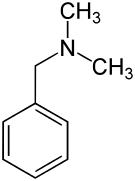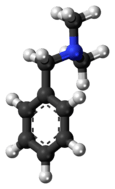Dimethylbenzylamine
| |||
| Names | |||
|---|---|---|---|
| IUPAC name
N,N-dimethyl-1-phenylmethanamine | |||
| Other names
N,N-Dimethylbenzenemethanamine, N,N-Dimethylbenzylamine, N-Benzyldimethylamine, Dimethylbenzylamine, Benzyl-N,N-dimethylamine, N-(Phenylmethyl)dimethylamine, BDMA, Sumine 2015, Benzenemethanamine, Dabco B-16, Araldite accelerator 062, N,N-Dimethyl(phenyl)methanamine | |||
| Identifiers | |||
| 3D model (JSmol) |
|||
| ChemSpider | |||
| ECHA InfoCard | 100.002.863 | ||
| EC Number | 203-149-1 | ||
| PubChem CID |
|||
| UNII | |||
| |||
| |||
| Properties | |||
| C9H13N | |||
| Molar mass | 135.21 g·mol−1 | ||
| Appearance | colourless to yellow liquid | ||
| Density | 0.91 g/cm3 at 20 °C | ||
| Melting point | −75 °C (−103 °F; 198 K) | ||
| Boiling point | 180 to 183 °C (356 to 361 °F; 453 to 456 K) | ||
| 1.2 g/100mL[1] (27 °C) | |||
| Hazards | |||
| R-phrases (outdated) | R10, R20, R21, R22, R34, R52, R53 | ||
| S-phrases (outdated) | S26, S36, S45, S61 | ||
| NFPA 704 | |||
| Flash point | 55 °C (131 °F; 328 K) | ||
| 410 °C (770 °F; 683 K) | |||
| Except where otherwise noted, data are given for materials in their standard state (at 25 °C [77 °F], 100 kPa). | |||
| | |||
| Infobox references | |||
Dimethylbenzylamine is the organic compound with the formula C6H5CH2N(CH3)2. The molecule contains the benzyl group, C6H5CH2, attached to a dimethylamino functional group. It is used as a catalyst for the formation of polyurethane foams and epoxy resins.
Like some other benzyl compounds, the molecule undergoes directed ortho metalation with butyl lithium. Because of this reaction, many derivatives are known with the formula 2-X-C6H4CH2N(CH3)2 (X = SR, PR2, etc.).
The amine is basic and undergoes quaternization with methyl iodide to give the ammonium salt [C6H5CH2N(CH3)3]+I−.[2] Such salts are useful phase transfer catalysts.
N,N-Dimethylbenzylamine can be synthesized by methylation of benzylamine with formic acid and formaldehyde according to the Eschweiler–Clarke reaction.[3][4][5]
References
- ↑ "Melting point".
- ↑ Brasen, W. R.; Hauser, C. R. (1963). "2-Methylbenzyldimethylamine". Org. Synth.; Coll. Vol., 4, p. 585
- ↑ Eschweiler, W. (1905). "Ersatz von an Stickstoff gebundenen Wasserstoffatomen durch die Methylgruppe mit Hülfe von Formaldehyd". Chem. Ber. 38: 880. doi:10.1002/cber.190503801154.
- ↑ Clarke, H. T.; Gillespie, H. B.; Weisshaus, S. Z. (1933). "The Action of Formaldehyde on Amines and Amino Acids". J. Am. Chem. Soc. 55 (11): 4571. doi:10.1021/ja01338a041.
- ↑ Icke, R. N.; Wisegarver, B. B.; Alles, G. A. (1945). "β-Phenylethyldimethylamine". Org. Synth.; Coll. Vol., 3, p. 723


